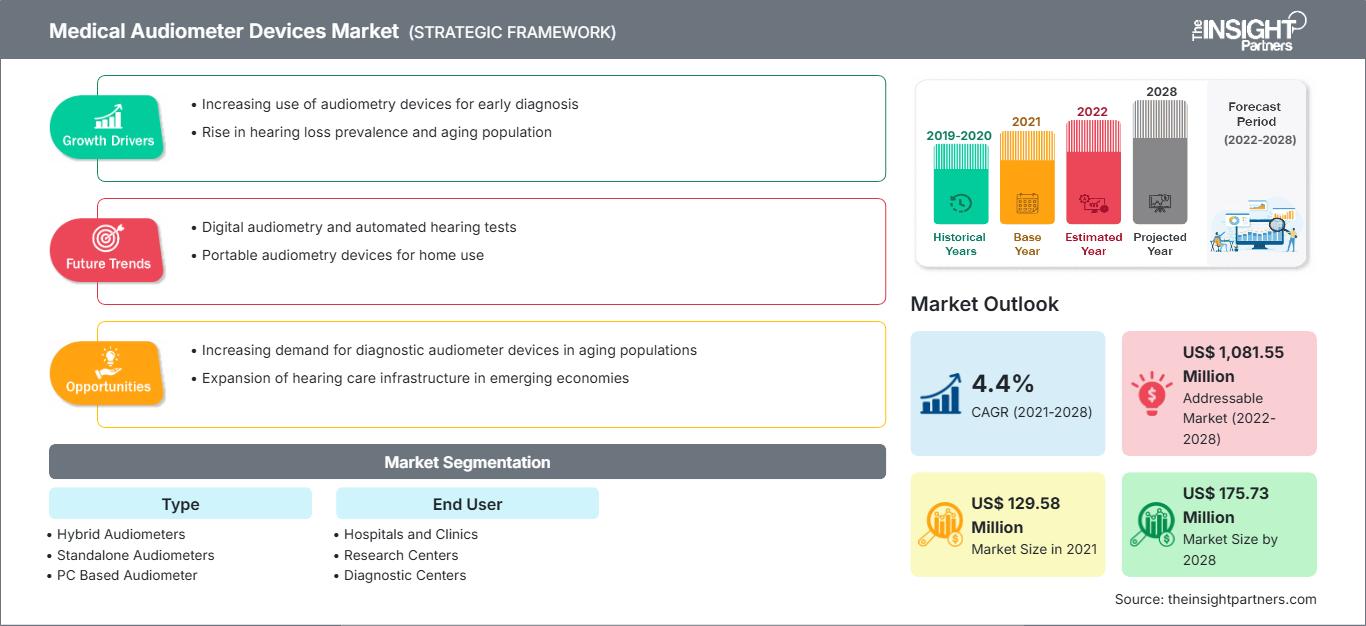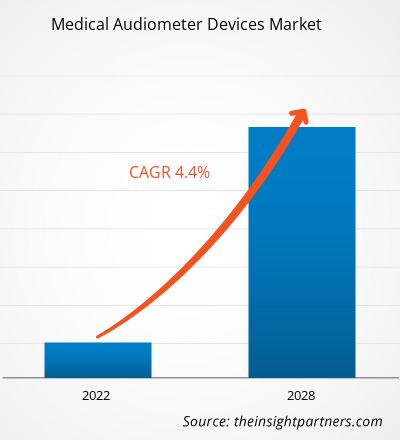Der Markt für medizinische Audiometer soll von 129,58 Millionen US-Dollar im Jahr 2021 auf 175,73 Millionen US-Dollar im Jahr 2028 anwachsen; von 2021 bis 2028 wird ein durchschnittliches jährliches Wachstum von 4,4 % erwartet.
Medizinische Audiometer sind Geräte zur Beurteilung des Hörvermögens und zur Messung und Diagnose des Schweregrads von Hörverlust. Audiometer bestehen aus eingebetteter Hardware und einer Feedback-Taste für den Testteilnehmer, die an einen Kopfhörer angeschlossen ist. Zur Steuerung des Systems wird ein herkömmlicher PC verwendet. Audiometrie ist eine Technik zur Bestimmung des Hörvermögens einer Person. Zu den audiometrischen Verfahren gehören Immittanzaudiometrie, Reintonaudiometrie, evozierte Reaktionsaudiometrie und Sprachaudiometrie. Verschiedene technologische Fortschritte haben zur Entwicklung von Hybrid-Audiometern und PC-basierten Audiometern zur Kommunikation und Verbesserung der Lebensqualität geführt.
Der Markt für medizinische Audiometer wurde nach Typ, Endbenutzer und Geografie segmentiert. Geografisch ist der Markt hauptsächlich in Nordamerika, Europa, den asiatisch-pazifischen Raum, den Nahen Osten und Afrika sowie Süd- und Mittelamerika unterteilt. Der Bericht bietet Einblicke und eine detaillierte Analyse des Marktes für medizinische Audiometer und beleuchtet Markttrends, technologische Fortschritte, Marktdynamik und eine Analyse der Wettbewerbslandschaft der weltweit führenden Marktteilnehmer.
Passen Sie diesen Bericht Ihren Anforderungen an
Sie erhalten kostenlos Anpassungen an jedem Bericht, einschließlich Teilen dieses Berichts oder einer Analyse auf Länderebene, eines Excel-Datenpakets sowie tolle Angebote und Rabatte für Start-ups und Universitäten.
Markt für medizinische Audiometergeräte: Strategische Einblicke

-
Holen Sie sich die wichtigsten Markttrends aus diesem Bericht.Dieses KOSTENLOSE Beispiel umfasst Datenanalysen, die von Markttrends bis hin zu Schätzungen und Prognosen reichen.
Markteinblicke
Steigende Prävalenz von Hörstörungen
Die Prävalenz von Hörstörungen nimmt weltweit zu. Hörstörungen können zu einer Beeinträchtigung des Hörvermögens von Geräuschen von über 40 Dezibel (dB) auf dem besser hörenden Ohr bei Erwachsenen und von über 30 dB auf dem besser hörenden Ohr bei Kindern führen. Hörstörungen können eine erbliche oder angeborene Behinderung sein oder durch Infektionskrankheiten, chronische Mittelohrentzündungen, übermäßige Lärmbelastung oder hohes Alter verursacht werden. Infektionen im Kindesalter wie Masern, Mumps und Meningitis, übermäßige oder lang anhaltende Lärmbelastung sowie chronische Mittelohrentzündungen können ebenfalls zu Hörstörungen führen. Schwerhörigkeit ist zur häufigsten Erkrankung bei Patienten geworden, insbesondere in Industrieländern. Laut der Weltgesundheitsorganisation (WHO) haben etwa 5 % der Weltbevölkerung eine Hörbehinderung. Die Zahl der Menschen, die mit dieser Krankheit leben müssen, wird bis 2050 voraussichtlich auf über 900 Millionen ansteigen. Nach Angaben der Hearing Industries Association wurden 2019 in den USA über 4,22 Millionen Hörgeräte verteilt, was einem Anstieg von 6,5 % gegenüber der Zahl im Jahr 2018 entspricht.
Dem Bericht „Hearing Loss Facts and Statistics 2018“ der Hearing Loss Association of America (HLAA) zufolge leiden etwa 48 Millionen Amerikaner an einem gewissen Grad von Hörverlust. Darin wird auch erwähnt, dass 2–3 von 1.000 Kindern in den USA mit einem erkennbaren Grad von Hörverlust auf einem oder beiden Ohren geboren werden. Laut Daten der Centers for Disease Control and Prevention berichten etwa 16 % der Erwachsenen in den USA von Hörproblemen, und jeder fünfte Mann und jede achte Frau gibt an, irgendeine Art von Hörproblemen zu haben. Hörverlust tritt doppelt so häufig auf wie Diabetes oder Krebs. Etwa 11 % der Amerikaner berichten von Tinnitus oder Ohrensausen.
Die zunehmende Verbreitung von Hörstörungen und Hörverlust in der Bevölkerung fördert daher den Absatz von medizinischen Audiometern.
Typbasierte Erkenntnisse
Basierend auf dem Typ ist der Markt für medizinische Audiometer in Hybrid-Audiometer, Standalone-Audiometer und PC-basierte Audiometer unterteilt. Das Segment der PC-basierten Audiometer dürfte 2021 den größten Marktanteil ausmachen, und das Segment der Hybrid-Audiometer dürfte im Prognosezeitraum die höchste durchschnittliche jährliche Wachstumsrate verzeichnen.
Endbenutzerbasierte Erkenntnisse
Basierend auf dem Endbenutzer ist der Markt für medizinische Audiometer in Krankenhäuser und Kliniken, Forschungszentren und Diagnosezentren unterteilt. Das Segment Krankenhäuser und Kliniken dürfte 2021 den größten Marktanteil halten und im Prognosezeitraum voraussichtlich die höchste durchschnittliche jährliche Wachstumsrate (CAGR) verzeichnen.
Die COVID-19-Pandemie hat sich weltweit zur größten Herausforderung entwickelt. Da diese Pandemie die Gesundheitssysteme weltweit belastet hat, war es unerlässlich, die begrenzten Ressourcen zu priorisieren, um Krankenhauseinweisungen zu minimieren. Marktteilnehmer haben jedoch einen innovativen Ansatz für Tele-Audiologie-Lösungen zur Behandlung von Patienten mit Hörverlust gewählt. Beispielsweise gilt Satellite Tele-Audiology Solutions, Teil des Unternehmens Inventis, als die erste Technologie ihrer Art. Diese Technologie ermöglicht es Audiologen, mit ihren Patienten in Echtzeit zu interagieren und aus der Ferne vollständige Hörtests durchzuführen. Solche Entwicklungen der führenden Marktteilnehmer haben dazu geführt, dass die COVID-19-Pandemie den Markt für medizinische Audiometer nur minimal beeinflusst hat.
Akquisitionen, Kooperationen, Partnerschaften, Produkteinführungen und Expansionen sind gängige Strategien von Unternehmen, um ihre Präsenz weltweit auszubauen und die wachsende Nachfrage zu decken. Die Akteure auf dem Markt für medizinische Audiometer verfolgen vor allem die Strategie der Produktinnovation, um der sich weltweit ändernden Kundennachfrage gerecht zu werden, was ihnen auch dabei hilft, ihren Markennamen weltweit zu behaupten.
Medizinische Audiometer
Regionale Einblicke in den Markt für medizinische AudiometerDie Analysten von The Insight Partners haben die regionalen Trends und Faktoren, die den Markt für medizinische Audiometer im Prognosezeitraum beeinflussen, ausführlich erläutert. In diesem Abschnitt werden auch die Marktsegmente und die geografische Lage medizinischer Audiometer in Nordamerika, Europa, im asiatisch-pazifischen Raum, im Nahen Osten und Afrika sowie in Süd- und Mittelamerika erläutert.
Umfang des Marktberichts über medizinische Audiometergeräte
| Berichtsattribut | Einzelheiten |
|---|---|
| Marktgröße in 2021 | US$ 129.58 Million |
| Marktgröße nach 2028 | US$ 175.73 Million |
| Globale CAGR (2021 - 2028) | 4.4% |
| Historische Daten | 2019-2020 |
| Prognosezeitraum | 2022-2028 |
| Abgedeckte Segmente |
By Typ
|
| Abgedeckte Regionen und Länder |
Nordamerika
|
| Marktführer und wichtige Unternehmensprofile |
|
Dichte der Marktteilnehmer für medizinische Audiometer: Verständnis ihrer Auswirkungen auf die Geschäftsdynamik
Der Markt für medizinische Audiometer wächst rasant. Die steigende Nachfrage der Endverbraucher ist auf Faktoren wie veränderte Verbraucherpräferenzen, technologische Fortschritte und ein stärkeres Bewusstsein für die Produktvorteile zurückzuführen. Mit der steigenden Nachfrage erweitern Unternehmen ihr Angebot, entwickeln Innovationen, um den Bedürfnissen der Verbraucher gerecht zu werden, und nutzen neue Trends, was das Marktwachstum weiter ankurbelt.

- Holen Sie sich die Markt für medizinische Audiometergeräte Übersicht der wichtigsten Akteure
Firmenprofile
- Benson Medical Instruments Co.
- Hedera Biomedics Srl
- Intelligente Diagnosegeräte
- Natus Medical Incorporated
- INVENTIS SRL
- Auditdata
- MedRx
- INTERACOUSTICS AS
- RESONANCE
- Hill Rom Holding Inc.
- Historische Analyse (2 Jahre), Basisjahr, Prognose (7 Jahre) mit CAGR
- PEST- und SWOT-Analyse
- Marktgröße Wert/Volumen – Global, Regional, Land
- Branchen- und Wettbewerbslandschaft
- Excel-Datensatz
Aktuelle Berichte
Verwandte Berichte
Erfahrungsberichte
Grund zum Kauf
- Fundierte Entscheidungsfindung
- Marktdynamik verstehen
- Wettbewerbsanalyse
- Kundeneinblicke
- Marktprognosen
- Risikominimierung
- Strategische Planung
- Investitionsbegründung
- Identifizierung neuer Märkte
- Verbesserung von Marketingstrategien
- Steigerung der Betriebseffizienz
- Anpassung an regulatorische Trends






















 Kostenlose Probe anfordern für - Markt für medizinische Audiometergeräte
Kostenlose Probe anfordern für - Markt für medizinische Audiometergeräte